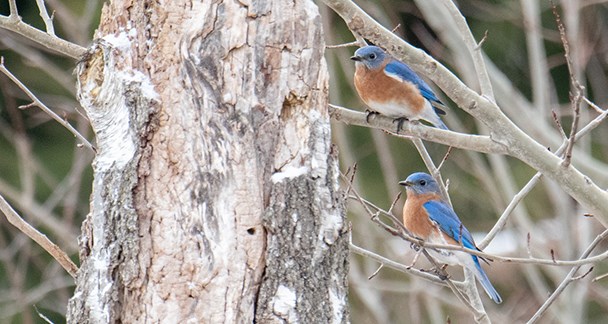The 2022 Christmas Bird Count produced some unexpected results, officials confirm. Birds that are usually found down south for the winter are staying for longer periods and finding new homes in Guelph.
The 56th annual Christmas Bird Count took place on Dec. 18.
A record 75 participants reported 68 species, slightly above the average of 66 for the last decade, and with a total of 12,998 birds. Visit Nature Guelph’s website for a detailed report.
There were no new species for the count, but six species had record numbers:
- greater white-fronted goose – two (one in 2006)
- trumpeter swan – 49 (36 in 2021)
- bald eagle – 13 (10 in 2021)
- belted kingfisher – 15 (13 in 2018)
- common raven – 58 (55 in 2021)
- hermit thrush – 3 (1 in 2009)
“The swan, eagle and raven have all been showing steady increases in recent years,” said Guelph Christmas Bird Count coordinator Mike Cadman.
“We’ve received our highest counts in the last few years. Numbers are gradually increasing, and we find that more birds are hanging around here later (into the winter)."
Because the fall season is getting milder with each year, Cadman says birds are staying later and the Christmas Bird Count reflects these changes in temperature.
“It’s not very surprising given climate change and the fact that the Christmas count happens at the beginning of the winter,” Cadman said.
Notable, but not a record, new reports for the American wigeon show increases, as well as for the eastern bluebird.
“The Common Raven is a year-round resident. The increase just reflects the fact that they are seen more often in this area,” Cadman said.
“And this year, we saw three Hermit Thrushes. These birds resemble small robins, but without the red breasts.”
Historically, Cadman says Hermit Thrushes were rarely seen in Guelph during the winter months.
“We would be lucky to see one bird over the whole winter. This year, we saw three at the count, which is a record, and we are finding them throughout the area. That’s quite a number compared to what we have ever seen before, and this is remarkable,” Cadman said.
“It’s quite possible that this won’t happen again next year. These things don’t always happen linearly, but the conditions were right this year for more birds to be hanging around.”
Weather conditions during the count, however, were poor for surveying birds, with strong winds and intermittent snow, which probably reduced counts for some species and the overall species total.
The great horned owl and merlin were notable absences, likely due to the poor weather.
Both were reported during the count, along with the golden eagle and snow goose. Winter finches were generally scarce with 25 common redpoll, one pine siskin and one purple finch. The exception was the 38 evening grosbeaks, the highest tally in over 20 years since the record 495 reported in 1977.
“The great horned owl is experiencing a long-term decline throughout our area and across southern Ontario. But the reason why we have none on the count, could be again, because of the windy conditions,” Cadman said.
“They are hard to see, but early in the morning, you can hear them calling if you are out at dawn. But because of the wind, they won’t bother calling. But the overall pattern is down. It is one of the species that we are worried about because of that long term decline.”
Since 1900, the Christmas Bird Count is North America's longest-running citizen science project. Participants in more than 2,000 locations throughout the western hemisphere participate in the count each year.
Cadman has been involved in the Guelph Christmas Bird Count since 1983.
"There have been a lot of changes in the last few years, that’s for sure,” Cadman said.
“Its just become a tradition. Most birders take part in the Christmas Bird Count. It’s a neat way to get out in the wintertime, but also, the idea behind it is to collect as much information that’s useful for science to understand what’s happening to bird population, and It’s also a really neat and social thing because you usually out with a group of people.”
Groups usually set out by 8 a.m. and stay out until about 5 p.m. on count day.
"But a lot of the groups will start earlier, at about 6 a.m. and do an hour or two looking for owls," Cadman said.
"Anyone with an interest can take part. It can be hard day in the field, so it tends to be people who are pretty keen and want to take part all day. Everyone is welcome."
Cadman says if a participant doesn’t really know their birds, they are welcome to join others.
"They can tag along with a group and with people who do know their birds. So, yes, It really is a great opportunity to learn about birds and about birding. And to see what kinds of birds are around that time of year," Cadman said.
He has been birding for years for over 50 years.
I was first interested when I was about five or six. I was bridging at 10 years old. So, it’s been a while," he said.
"I worked in wildlife services. That was my career. I organized volunteers to collect data. I’ve always been of the view that bird watchers have this wonderful knowledge of the natural world that very few people have. They love going outdoors and looking for birds and counting them."
Cadman says finding good data allows researchers to figure out what the challenges are.
"This is a very important thing to me and very satisfying. For me, it’s a great way to apply your skill set for a useful purpose. Birders love birds and we want to do everything we can to help conserve them,” Cadman said.
“I've just retired recently, so I am spending lots of time outside now, counting birds.”
For more information, visit Nature Guelph, here.



.png;w=120;h=80;mode=crop)